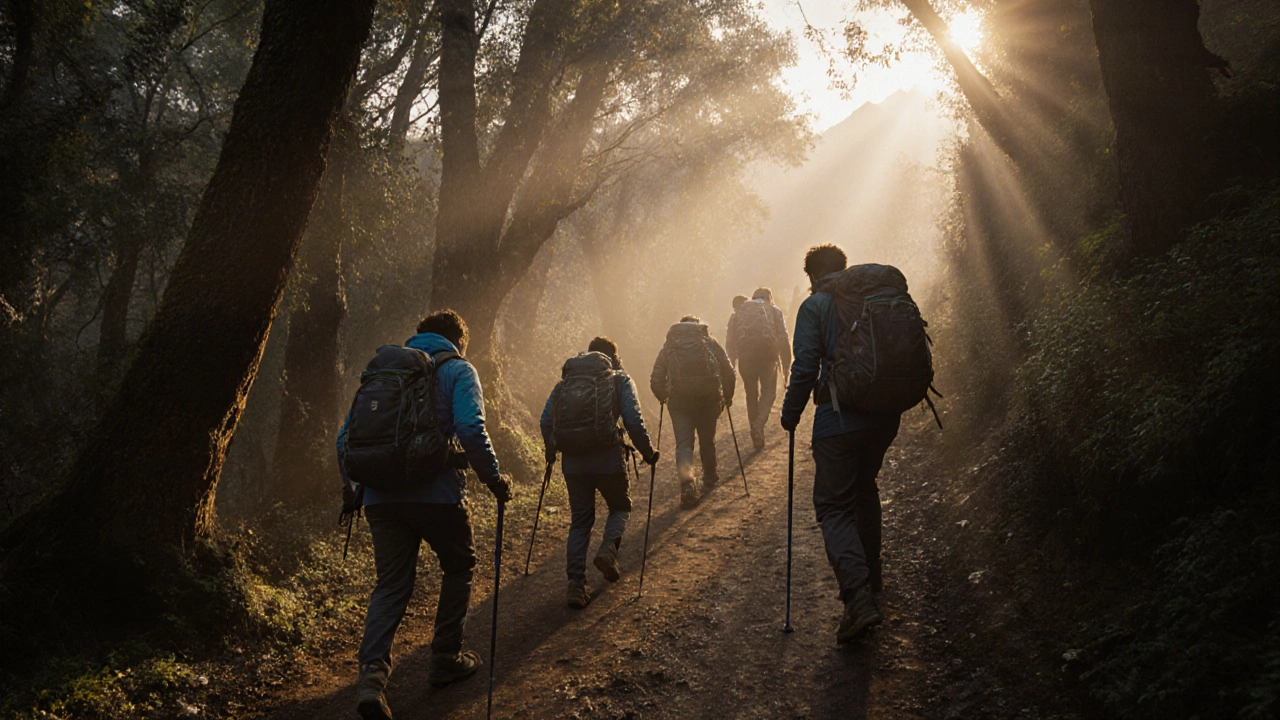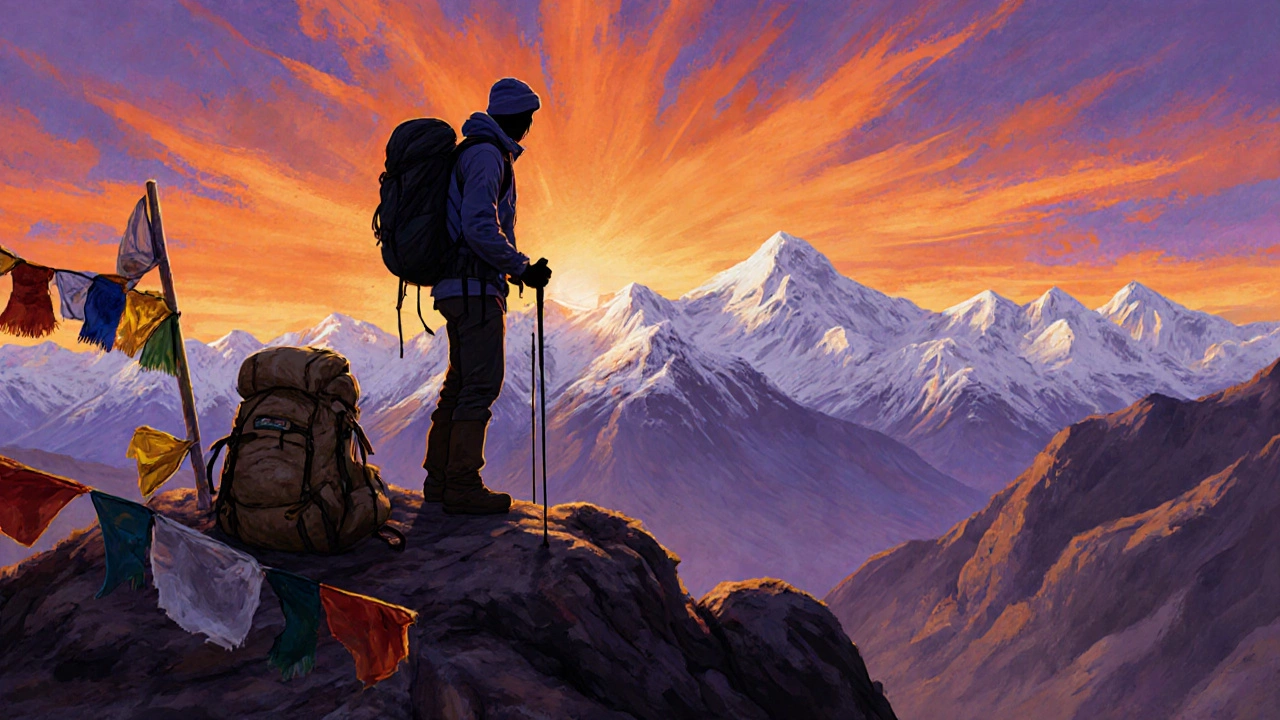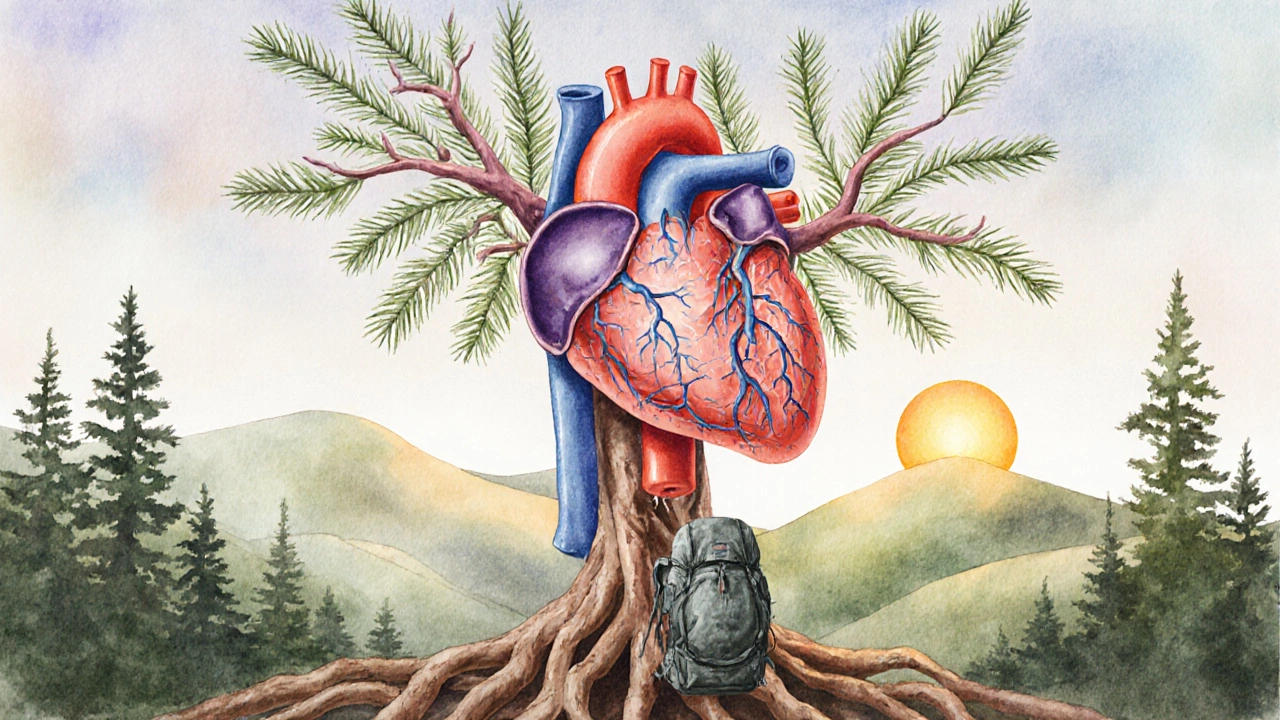Is Trekking Good for Health? The Real Benefits Beyond the Scenery
 Oct, 30 2025
Oct, 30 2025
Trekking Calorie Calculator
Calculate how many calories you burn during trekking based on your weight, terrain difficulty, and time spent walking. Trekking burns 400-600 calories per hour on hilly terrain—more than jogging! This calculator shows how trekking can help with weight management.
Estimated Calories Burned:
How this works: Trekking burns 400-600 calories per hour on hilly terrain. Your estimate is based on your weight and terrain type. The range shown represents the minimum and maximum calories burned for your input.
Ever come back from a long trek feeling like you’ve been reset? Not just tired-actually lighter, clearer, calmer? That’s not just in your head. Trekking isn’t just about chasing views or checking off mountain peaks. It’s one of the most effective, natural, and accessible ways to improve your physical and mental health. And if you’ve ever wondered whether lacing up boots and walking for hours through hills and forests actually does anything for your body, the answer is a clear yes.
Stronger Heart, Lower Blood Pressure
Trekking is steady, sustained movement. Unlike sprinting or high-intensity workouts, it keeps your heart pumping at a moderate pace for hours. That’s exactly what your cardiovascular system needs. A 2023 study in the Journal of Sports Medicine tracked 1,200 regular trekkers over two years. Those who walked at least 10 hours a week on uneven terrain saw an average 12% drop in resting heart rate and a 9% reduction in systolic blood pressure. That’s comparable to the effect of some medications-but without the side effects.
Why does terrain matter? Unlike walking on a flat treadmill, trekking forces your body to adjust constantly. Uphill climbs engage your glutes and quads harder. Downhill sections work your stabilizing muscles and improve joint control. Rocks, roots, mud-they all demand more from your core and legs than pavement ever could. Your heart learns to pump more efficiently. Your arteries become more flexible. Over time, your risk of heart disease drops significantly.
Weight Management Without the Grind
If you’ve tried counting calories, skipping meals, or doing endless ab workouts, you know how unsustainable they can be. Trekking doesn’t feel like a chore. It feels like adventure. And that’s why it works better for long-term weight control.
A 70 kg person trekking at a moderate pace on hilly trails burns between 400 and 600 calories per hour. That’s more than jogging on flat ground. But here’s the kicker: you don’t notice it. You’re too busy taking photos, spotting wildlife, or chatting with your group. You’re not thinking about burning fat-you’re thinking about the next ridge. Studies show people who lose weight through active outdoor hobbies like trekking are 3x more likely to keep it off than those who stick to gym routines. Why? Because it’s enjoyable. And enjoyment means consistency.
Stronger Bones and Joints
Here’s something most people don’t expect: trekking helps prevent osteoporosis. Weight-bearing activity is key to bone density, and trekking delivers it naturally. Carrying a backpack adds load. Stepping over rocks and climbing stairs on trails applies controlled stress to your hips, spine, and legs. That stress signals your body to strengthen those bones.
And yes, it’s good for your knees too-if done right. Contrary to popular belief, trekking doesn’t wreck your joints. In fact, a 2024 study from the University of Delhi found that regular trekkers over 50 had 30% less cartilage degeneration than sedentary peers. Why? The slow, controlled motion increases joint lubrication and strengthens the muscles around the knees and ankles. The trick? Use trekking poles. They cut impact on your knees by up to 25% and improve balance.
Mental Reset: Nature’s Therapy
Stress isn’t just in your head-it’s in your body. High cortisol levels lead to inflammation, poor sleep, and brain fog. Trekking interrupts that cycle. When you’re surrounded by trees, mountains, and silence, your brain shifts out of fight-or-flight mode. The scent of pine, the sound of wind, the rhythm of your footsteps-all of it activates the parasympathetic nervous system.
Researchers at Stanford found that people who walked for 90 minutes in nature showed reduced activity in the part of the brain linked to rumination (overthinking). That’s the mental loop that feeds anxiety and depression. After a long trek, many report feeling “clear-headed” for days. It’s not magic. It’s biology. Sunlight boosts vitamin D and serotonin. Fresh air increases oxygen flow to the brain. Quiet reduces sensory overload. Together, they create a natural antidepressant effect.

Improved Sleep and Energy Levels
If you’re lying awake at 2 a.m. scrolling through your phone, trekking might be the missing piece. Physical exertion, exposure to natural light, and reduced screen time all help regulate your circadian rhythm. A 2025 survey of 800 Indian trekkers showed that 78% reported falling asleep faster and sleeping more deeply after a weekend trek. Even better, they felt more energized during the day-not drained.
That’s because trekking doesn’t just tire you out-it resets your internal clock. Morning sun on the trail tells your brain it’s daytime. Evening quiet tells it it’s time to wind down. No blue light. No caffeine crashes. Just natural cues. And when your sleep improves, your immunity, focus, and mood all follow.
Building Resilience, One Step at a Time
Trekking teaches you how to handle discomfort. You’re cold. You’re tired. Your feet hurt. But you keep going. That’s not just physical endurance-it’s mental toughness. Each time you push past the urge to quit, you rewire your brain to handle stress better in daily life.
People who trek regularly report higher levels of self-efficacy-the belief that they can handle tough situations. That’s not just a feel-good phrase. It’s a measurable trait linked to lower rates of burnout, better decision-making under pressure, and even improved relationships. Trekking doesn’t just change your body. It changes how you see yourself.
What About Beginners? Is It Safe?
You don’t need to climb Everest to get the benefits. Start small. A 5-kilometer trail with a 200-meter elevation gain is enough. The key is consistency, not intensity. Walk three times a week. Add a little more distance or height each month. Use proper footwear. Stay hydrated. Listen to your body.
If you have existing health issues-like heart disease, diabetes, or joint problems-talk to your doctor first. But don’t assume you’re excluded. Many people with chronic conditions use trekking as part of their rehab. Modified treks with shorter routes and rest stops can be incredibly therapeutic.

Why India Is One of the Best Places to Start
India offers some of the most diverse trekking terrain on Earth. From the snow-capped peaks of Ladakh to the misty hills of Coorg, from the grasslands of Nagaland to the Western Ghats of Kerala, there’s a trail for every level. The trails are often less crowded than in the Alps or Rockies. Local guides know the land, the weather, and the hidden spots. And the cost? You can do a week-long trek for less than $200, including food and lodging.
And it’s not just about the path. It’s about the culture. Trekking in India means passing through villages where people wave and offer chai. It means seeing prayer flags fluttering above monasteries. It means waking up to the smell of woodsmoke and the sound of temple bells. That connection to place adds another layer to the healing.
What You’ll Need to Get Started
- Footwear: Sturdy, broken-in hiking boots with ankle support
- Backpack: Lightweight, with a hip belt to distribute weight
- Layered clothing: Moisture-wicking base, insulating mid-layer, waterproof outer shell
- Water: At least 2 liters per person, plus a filter or purification tablets
- Trekking poles: Especially helpful on descents and uneven ground
- First-aid kit: Blister pads, pain relievers, antiseptic wipes
You don’t need fancy gear. You need to be prepared. Start with what you have. Borrow if you have to. The trail doesn’t care how much you spent on your boots-it cares that you showed up.
Final Thought: It’s Not About the Summit
The real reward of trekking isn’t standing on top of a mountain. It’s how you feel when you come down. Your shoulders are looser. Your mind is quieter. Your body feels strong, not sore. You slept like a baby. You laughed more than you did all month.
Trekking isn’t a workout. It’s a return to something older, deeper, and more natural. Your body didn’t evolve to sit at a desk. It evolved to walk-over rocks, through forests, up hills, under open skies. Trekking brings that back. And that’s why it’s not just good for your health. It’s essential for it.
Is trekking good for weight loss?
Yes, trekking is excellent for weight loss because it burns 400-600 calories per hour on hilly terrain. Unlike gym workouts, it’s sustainable because it feels like an adventure, not a chore. People who lose weight through trekking are more likely to keep it off long-term because they enjoy the activity and stick with it.
Can trekking help with anxiety and depression?
Yes. Studies show that spending time in nature during trekking reduces activity in the brain’s rumination center-the area linked to overthinking and negative thoughts. Sunlight boosts serotonin, fresh air increases oxygen flow, and physical movement lowers cortisol. Many people report feeling calmer and clearer for days after a trek.
Do I need to be fit to start trekking?
No. You don’t need to be in peak shape. Start with short, easy trails-5 km with gentle elevation. Use trekking poles to reduce strain. Walk three times a week, and gradually increase distance and difficulty. Many people with joint issues or chronic conditions use modified treks as part of their recovery plan.
Is trekking hard on the knees?
Not if done correctly. Trekking strengthens the muscles around your knees and improves joint lubrication. Using trekking poles reduces impact by up to 25%. A 2024 study found trekkers over 50 had 30% less cartilage degeneration than sedentary people. Avoid steep descents without poles, and listen to your body.
What’s the best time of year to trek in India?
October to March is ideal for most Indian treks. The weather is cool and dry, with clear skies. Monsoon season (June-September) brings heavy rain and landslides. Summer (April-June) can be extremely hot in lower elevations. High-altitude treks like Ladakh are best from June to September when snow has melted.
How often should I trek to see health benefits?
Aim for at least 3 hours per week-spread over two or three outings. Even a 2-hour weekend trek can lower blood pressure, improve sleep, and reduce stress. Consistency matters more than intensity. You’ll notice changes in energy, mood, and stamina within 4-6 weeks.
Next Steps: Where to Begin
Start by picking one nearby trail. Google “easy treks near [your city]” or check local outdoor clubs. Try a 5-8 km loop with a bit of climb. Go with a friend. Bring water. Wear good shoes. Don’t rush. Just move. The mountain isn’t going anywhere. But your health is.